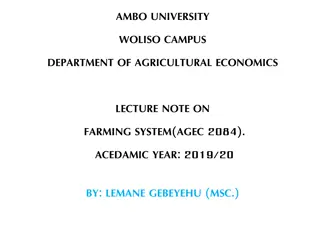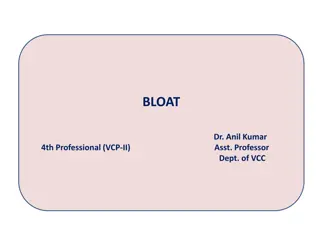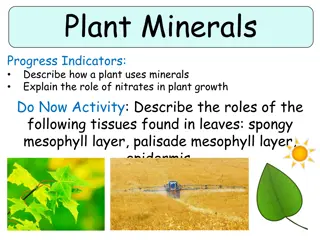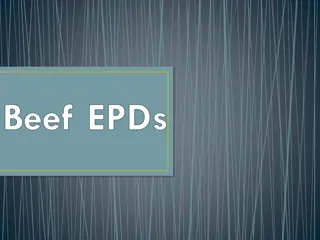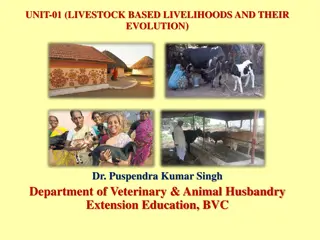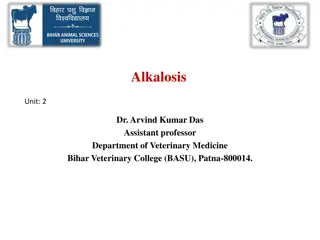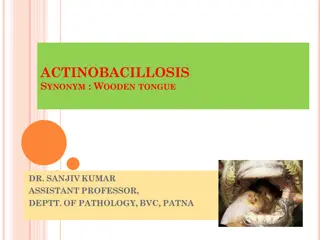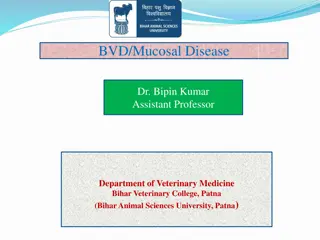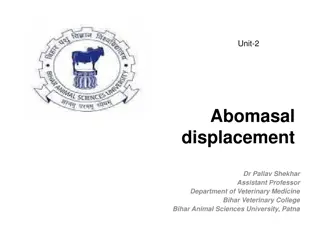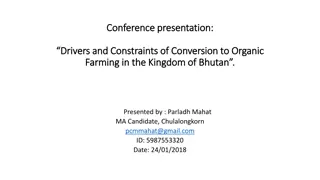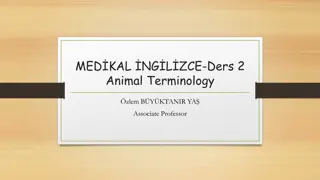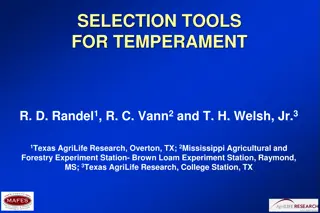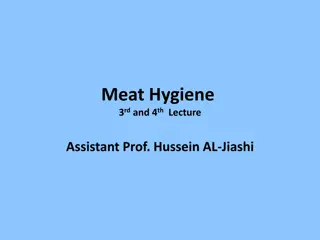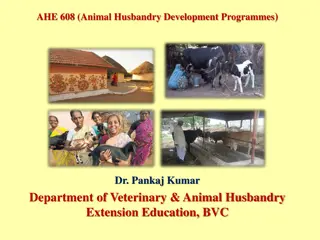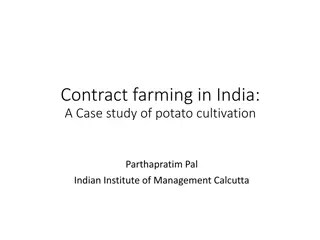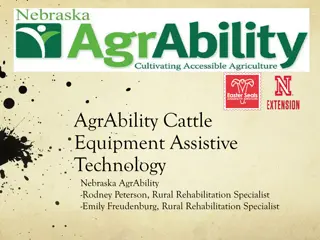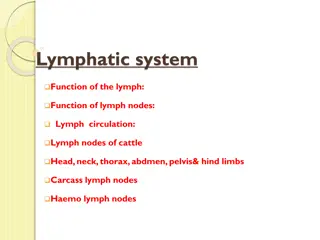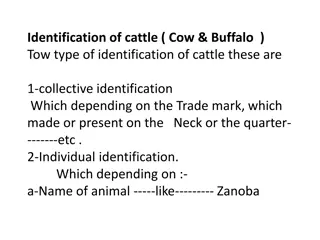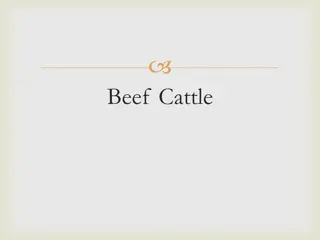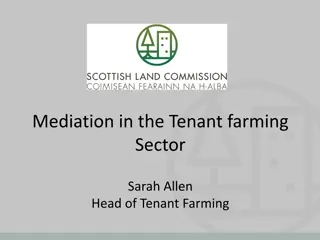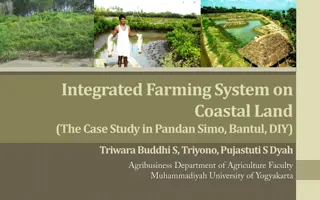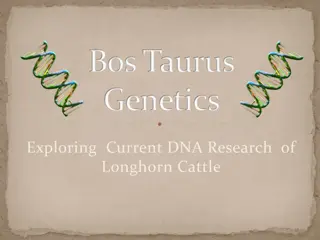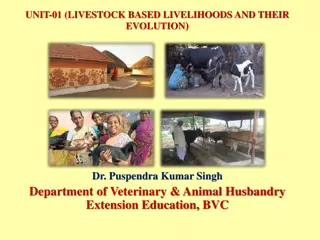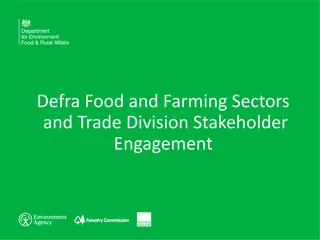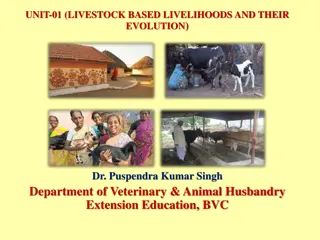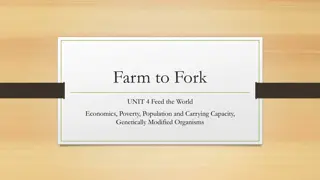Understanding Farming Systems in Agricultural Economics
Concepts of farming systems research and development are crucial for effective agricultural management. A farming system encompasses various components that work together to achieve specific objectives. It involves the arrangement and management of farming enterprises in response to environmental fa
0 views • 49 slides
Understanding Bloat in Cattle: Causes, Symptoms, and Treatment
Bloat in cattle, characterized by overdistension of the rumenoreticulum with gases of fermentation, can be caused by various factors including diet, obstruction, or diseases. Frothy bloat and free gas bloat are common types, each with its own triggers and symptoms. Diagnosis involves a thorough hist
1 views • 8 slides
Organic vs Conventional Farming: An Overview
In the debate between organic and conventional farming, both methods have their pros and cons. While organic foods are perceived to follow stricter safety standards, both types meet FDA and USDA regulations. They offer similar nutritional value, but organic farming tends to have lower efficiency due
0 views • 6 slides
Plant Minerals and Farming Methods
Learn about how plants use minerals for growth, the role of nitrates, different leaf tissues, mineral deficiencies, and farming methods to ensure crop yield. Discover how plants obtain minerals from the soil, symptoms of mineral deficiencies, and the importance of fertilizers in farming. Explore dif
0 views • 13 slides
Understanding Expected Progeny Differences (EPDs) in Beef Cattle Selection
Expected Progeny Differences (EPDs) in beef cattle breeding predict future offspring performance based on genetic merit. They help compare animals as parents and aid in selecting for traits like birth weight, weaning weight, and yearling weight. Combining EPDs with visual appraisal improves decision
0 views • 15 slides
Overview of Livestock Production: Cattle, Sheep, and Goat Breeds
Explore the diverse world of livestock production, including cattle ranching, dairy farming, hog and pig farming, poultry and egg production, and animal aquaculture. Delve into the specifics of sheep and goat production, from breeds and production systems to management practices, breeding techniques
1 views • 43 slides
Diverse Methods of Poultry Farming and Agricultural Practices
Poultry farming practices such as organic farming, nitrogen fixation, biodiversity management, and contract farming are discussed. Organic farming emphasizes holistic relationships in agriculture, promoting sustainable production. Nitrogen fixation and biodiversity management play essential roles in
0 views • 20 slides
Livestock Breeding Policy for Genetic Improvement of Cattle and Buffalo in India
India's diverse agro-ecological regions host a wide range of farm animal breeds. The livestock breeding policy aims to enhance the productivity of cattle and buffalo through strategies such as grading up with indigenous superior dairy breeds, crossbreeding with high-yielding exotic breeds, and selec
1 views • 23 slides
Evolution of Livestock-based Livelihoods and Capitalistic Farming Systems
Livestock-based livelihoods have evolved over time, with capitalistic farming systems emerging as prominent in regions like South America, North America, and Europe. These systems are characterized by individual entrepreneurs controlling farming activities. Plantations are a common example of capita
0 views • 10 slides
Understanding Alkalosis in Cattle: Causes and Pathophysiology
Alkalosis in cattle, particularly ruminal alkalosis, can be caused by issues such as abomasal atony and alkaline indigestion. Excessive intake of protein-rich feed and changes in diet play a significant role. Pathophysiology involves the accumulation of ruminal ammonia, leading to alkaline pH and ru
1 views • 13 slides
Livestock-based Livelihoods and Farming Systems Evolution
Livestock-based livelihoods and farming systems have evolved over time, aiming to produce food and crops sustainably. Small-scale farming, farm management, types of farming, and various farming systems like specialized and diversified farming play key roles in enhancing productivity, profitability,
9 views • 19 slides
Actinobacillosis (Wooden Tongue) in Cattle and Sheep: Overview of the Infectious Disease
Actinobacillosis, also known as Wooden Tongue, is a specific infectious disease affecting cattle and sheep, caused by Actinobacillus lignieresii. It is characterized by fibrosis of the tongue and soft tissues, leading to mobility issues. The disease is primarily transmitted through wounds and abrasi
0 views • 8 slides
Contract Farming in India: A Case Study of Potato Cultivation
Value addition in Indian agriculture is low due to poor processing levels. Contract farming is being considered to integrate agriculture production into the global value chain, but concerns about unequal bargaining power between farmers and corporations exist. Various forms of contract farming exist
0 views • 26 slides
Understanding Bovine Virus Diarrhea and Mucosal Disease in Cattle
Bovine Virus Diarrhea (BVD) and Mucosal Disease (MD) are two clinically distinct yet interconnected syndromes in cattle caused by Pestivirus. While originally thought to be separate, they share a common viral etiology. BVD can lead to persistent infections, while MD is sporadic, progressive, and fat
0 views • 14 slides
Understanding Abomasal Displacement in Dairy Cattle: Causes, Symptoms, and Management
Abomasal displacement is a common issue in older lactating dairy cattle, often related to inadequate nutrition and concurrent diseases. This condition involves the displacement of the abomasum from its normal position, causing symptoms like anorexia, ketosis, and dehydration. Learn about the causes,
1 views • 21 slides
Exploring Drivers and Constraints of Conversion to Organic Farming in Bhutan
Population in Bhutan heavily relies on agriculture, but the transition to organic farming has been slow despite the desire to reduce chemical use. This presentation investigates the current state of organic farming, identifies key factors affecting conversion, and offers policy recommendations to pr
0 views • 22 slides
Animal Terminology in Livestock Farming
Animal terminology in livestock farming includes terms like breed, dam, flock, herd, livestock, polled, sire, litter, chickens, cattle, ducks, and goats. Understanding these terms is essential for those involved in animal husbandry and farming. This comprehensive guide provides definitions and expla
1 views • 18 slides
Understanding Sand Crack in Cattle Hooves: Causes, Signs, and Treatment
Sand crack, a fissure of the horny wall in cattle hooves, can present transversely or longitudinally. It commonly affects dairy breeds and is predisposed by various factors such as overgrowth of digital horn and chronic laminitis. Diagnosis and treatment differ based on the form of the crack, with s
0 views • 10 slides
Understanding Cattle Temperament: Implications for Producers
Cattle temperament plays a crucial role in the overall well-being of livestock and can impact factors such as stress levels, growth rates, and immune function. This article delves into the importance of evaluating and managing temperament in cattle to mitigate risks of injury, reduce stress-related
2 views • 32 slides
Common Infective Diseases in Cattle and Their Implications
Infective diseases such as blackquarter, brucellosis, and foot and mouth disease pose significant threats to cattle health and food safety. Blackquarter is a fatal disease caused by Clostridium chauvaei, while brucellosis leads to contagious abortion in cattle. Foot and mouth disease is highly conta
0 views • 17 slides
Dairy Cattle Production Systems in Ethiopia: Overview and Practices
Ethiopia has a favorable environment for dairy development with diverse production systems including pastoralism, agro-pastoralism, and mixed farming. The country boasts indigenous and exotic dairy cattle breeds, supporting milk production and utilization. This article outlines the different dairy p
2 views • 38 slides
Animal Husbandry Development Initiatives in India: Gaushalas and Gosadans
Animal Husbandry Development Programmes in India have a rich history dating back thousands of years, with initiatives like Gaushalas and Gosadans playing a significant role in preserving indigenous cattle breeds, promoting milk production, and supporting rural economies. Gaushalas aim to breed and u
0 views • 10 slides
Agricultural Practices and Major Crops in India
India is predominantly an agricultural-based country with two-thirds of its population engaged in farming. The country practices different types of farming, including primitive subsistence farming, intensive subsistence farming, and commercial farming. The cropping seasons in India are classified as
0 views • 8 slides
Contract Farming in India: Enhancing Agricultural Value Chain Through Partnerships
Value addition in Indian agriculture has been low due to limited processing levels. Contract farming is emerging as a viable solution to integrate agriculture production into the global value chain, albeit with concerns about unequal bargaining power. Various forms of contract farming exist, with ex
0 views • 26 slides
History and Vocabulary of Cattle Farming
Explore the rich history of cattle farming, from the introduction of longhorn cattle in America by the Spanish to the importation of European dairy cattle to Jamestown Colony. Learn about various terms and concepts associated with cattle, such as castration, heifer, marbling, and more. Delve into th
0 views • 36 slides
Addressing Challenges in the Cattle Market: A Call to Action
Explore the concept of Black Swan events in the cattle market and how they can affect market dynamics negatively. The presentation by R-CALF USA delves into instances where markets respond counter to fundamentals and overreact to minor stimuli. Issues such as high captive supply levels and import sp
0 views • 12 slides
Enhancing Cattle Farming with Assistive Technology in Nebraska
Nebraska AgrAbility specialists, Rodney Peterson and Emily Freudenburg, discuss the impact of modern equipment on cattle farmers with disabilities. They highlight the evolution of technology in cattle farming, introduce a new hydraulic feed box for efficient feeding, and provide vendor contact infor
0 views • 25 slides
Understanding Cattle Management and Classification
Cattle, belonging to the genus Bos, are classified into three types - Bos Taurus, Bos Indicus, and Bos Africans. They are ruminants with fixed hollow horns, udders with four teats, and males have teats on the scrotum. Cattle are utilized for milk production, agriculture, and meat manufacturing. They
0 views • 70 slides
Feasibility Study: Measuring Ruminal Contractions of Cattle Using an Inexpensive Electronic Veterinary Stethoscope
Effects of gastrointestinal motility in understanding disease and nutrition in cattle are actively researched. This study explores monitoring ruminal contractions using a cost-effective electronic stethoscope. The device, developed with Arduino technology, showed promising results in capturing inter
0 views • 35 slides
Understanding the Lymphatic System in Cattle: Nodes, Circulation, and Function
The lymphatic system in cattle plays a crucial role in maintaining overall health. It consists of lymph nodes located in various regions of the body such as the head, neck, abdomen, and hind limbs. These lymph nodes produce lymphocytes and help in filtering foreign bodies. Lymph fluid, similar to bl
0 views • 39 slides
Cattle Identification Methods and Characteristics Explained
Explore different methods of identifying cattle including collective and individual methods such as branding, tattooing, and tagging. Learn about cattle species, breeds, colors, and aging factors like dentition and parturition. Discover the main color variations in cattle such as yellow, red, black,
0 views • 36 slides
Overview of Beef Cattle Breeds and Characteristics
In the United States, there are over 80 recognized breeds of beef cattle, each with its own advantages and disadvantages. British breeds like Angus and Hereford offer low birth weight and high fertility, while European breeds like Charolais and Simmental excel in growth rate and milk production. Oth
0 views • 24 slides
Enhancing Mediation in the Tenant Farming Sector
Sarah Allen, Head of Tenant Farming, leads initiatives to promote mediation in the tenant farming sector, aiming to improve relationships between landlords and tenants. The Tenant Farming Commissioner under the Land Reform Act 2016 encourages mediation for resolving complex disputes. The pilot media
0 views • 9 slides
Integrated Farming System on Coastal Land: A Case Study in Pandan Simo, Bantul, DIY
The coastal area in Pandan Simo, Bantul, is embracing integrated farming systems combining food crops, horticulture, and livestock due to diminishing agricultural land. Farming on marginal lands like beaches has become a prevalent alternative. This case study aims to assess farming feasibility and r
0 views • 10 slides
Exploring Longhorn Cattle Genetics Through DNA Research
Longhorn cattle genetics are being investigated through DNA research to identify unique traits and differentiate them from other cattle breeds. By analyzing genetic codes with scatter plot graphs, scientists aim to map the genetic makeup of Longhorns accurately. This research helps in understanding
0 views • 9 slides
Evolution of Livestock-Based Livelihoods: From Estate Farming to Specialized Crop Cultivation
Estate farming, a form of industrialized agriculture introduced by the British in the 19th century, involves large monocultures of cash crops like tea, rubber, and spices. It requires significant investment in modern farming techniques, machinery, and skilled labor. Estate farming is capital-intensi
0 views • 8 slides
Study on Climate Change and Organic Farming Impact by Madhyanchal Forum
Madhyanchal Forum conducted a study on the impact of climate change on agriculture and the effectiveness of organic farming in mitigating climate change. The study involved various organizations and farmers across different regions, focusing on the adoption of sustainable farming practices. Detailed
0 views • 16 slides
Sustainable Farming Incentive Stakeholder Engagement Meeting
The meeting hosted by Defra's Food and Farming Sectors and Trade Division aims to gather feedback on the Sustainable Farming Incentive pilot standards and payment processes. Stakeholders in the Arable Sector can provide expert input to shape the development of the program, ensuring farmers' active p
0 views • 20 slides
Evolution of Livestock-Based Livelihoods in Agriculture
Livestock-based livelihoods, including extensive farming, play a significant role in agriculture. Extensive farming involves minimal inputs of labor, capital, and fertilizers per unit of land. It commonly refers to sheep and cattle farming in low-productivity areas. The system relies on natural soil
0 views • 8 slides
Sustainable Agriculture: Feeding the World and Future Farming Practices
Explore the dynamics of farming from rural to urban settings, understanding factors like supply and demand, seasonal eating, and sustainable agriculture practices through the lens of economic, poverty, and population considerations. Discover how different farming practices meet market demands, how r
0 views • 55 slides
